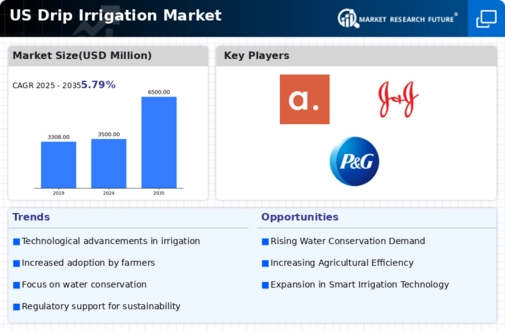Rising Crop Demand
The rising demand for crops in the US is a significant driver of the drip irrigation market. With the population growth and changing dietary preferences, there is an increasing need for efficient agricultural practices to meet food production goals. Drip irrigation systems enable farmers to maximize crop yields while minimizing water usage, which is essential in a competitive market. According to recent data, the agricultural sector in the US is projected to grow by approximately 3% annually, further emphasizing the need for innovative irrigation solutions. This trend suggests that the drip irrigation market will likely benefit from the heightened focus on productivity and sustainability in agriculture.
Water Scarcity Concerns
The increasing concerns regarding water scarcity in the US are driving the drip irrigation market. As agricultural practices face challenges due to diminishing water resources, farmers are seeking efficient irrigation solutions. Drip irrigation systems, which deliver water directly to the plant roots, can reduce water usage by up to 50% compared to traditional methods. This efficiency not only conserves water but also enhances crop yield, making it an attractive option for farmers. The US government has recognized the importance of water conservation, leading to initiatives that promote the adoption of advanced irrigation technologies. Consequently, the drip irrigation market is likely to experience growth as more farmers adopt these systems to address water scarcity issues.
Government Incentives and Subsidies
Government incentives and subsidies play a crucial role in promoting the adoption of drip irrigation systems in the US. Various federal and state programs provide financial assistance to farmers who invest in efficient irrigation technologies. For instance, the USDA offers grants and low-interest loans to support the implementation of water-saving practices. These financial incentives can cover a significant portion of the installation costs, making drip irrigation more accessible to a broader range of farmers. As a result, the drip irrigation market is expected to expand as more farmers take advantage of these programs to modernize their irrigation practices and improve water efficiency.
Technological Integration in Agriculture
The integration of advanced technologies in agriculture is transforming the drip irrigation market. Innovations such as IoT devices, sensors, and data analytics are enhancing the efficiency and effectiveness of irrigation systems. These technologies allow farmers to monitor soil moisture levels and adjust irrigation schedules accordingly, optimizing water usage. The US agricultural sector is increasingly adopting precision farming techniques, which align well with the capabilities of drip irrigation systems. As farmers seek to leverage technology for improved crop management, the drip irrigation market is poised for growth, driven by the demand for smarter, data-driven irrigation solutions.
Environmental Regulations and Sustainability Goals
Environmental regulations and sustainability goals are influencing the drip irrigation market in the US. As concerns about climate change and resource depletion grow, regulatory bodies are implementing stricter guidelines for water usage in agriculture. Drip irrigation systems, known for their water efficiency, align with these sustainability objectives. Farmers are increasingly adopting these systems to comply with regulations and demonstrate their commitment to environmentally friendly practices. The US government is also promoting sustainable agriculture through various initiatives, further driving the adoption of drip irrigation. This trend indicates a strong potential for growth in the drip irrigation market as sustainability becomes a priority for agricultural stakeholders.














Leave a Comment